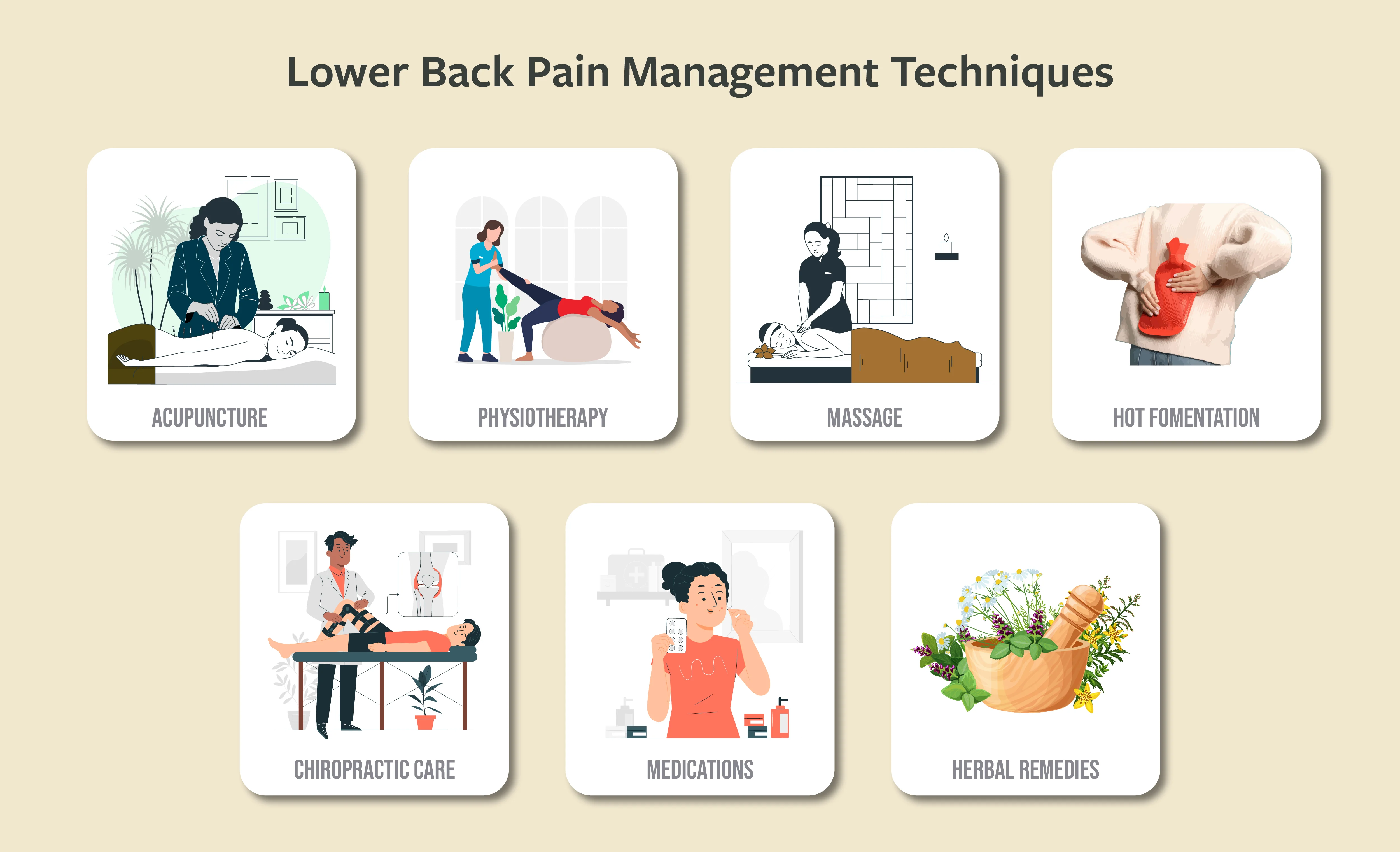Natural Remedies for Lower Back Pain

We explored various causes of lower back pain as well as prevention techniques in our last blog, now let’s look further into management strategies. Managing pain in the lower back is crucial for many things, mental health included. Your ability to execute everyday activities comfortably, like bathing or lifting, might also be impacted. The lower back, also referred to as the lumbar region, is responsible for structural support, shock absorption, mobility, flexibility and so much more. It’s not surprising why so many patients seek medical or professional help to get their lower back pain treated.
Management Strategies for Lower Back Pain
Managing lower back pain requires a multifaceted approach. Acupuncture is a popular method that stimulates specific points in the body, potentially alleviating pain by rebalancing energy flow. This ancient practice is known in modern medicine for its analgesic effects. You could also consider managing your lower back pain with physiotherapy. It focuses on strengthening the muscles that support the spine and improving flexibility. A skilled physiotherapist can tailor exercises and stretches to address specific issues, promoting better posture and reducing the risk of recurrent pain.

Massages are another effective option, especially coupled with herbal infusion oils. Herbal infusion oils increase blood flow and decrease muscle tension. Hot fomentation, which involves the application of heat to relax muscles and reduce stiffness, is another effective management option. Chiropractic care, focussing on spinal manipulation to improve alignment, is a widely accepted treatment for lower back pain and can offer significant relief. For those who require medical intervention, medications like anti-inflammatory drugs, muscle relaxants, and antidepressants may be prescribed to manage pain and address underlying conditions, though they come with their own side effects and shortcomings.

Herbal Remedies for Lower Back Pain
You could also consider a few herbal remedies. Curcuma Longa (Turmeric), and specifically its active ingredient curcumin, has been widely studied for its anti-inflammatory effects, making it a valuable addition to any pain management formulation. Boswellia Serrata, commonly known as Shallaki, contains boswellic acid and is a potent anti-inflammatory herb that can help reduce swelling and pain in the lower back. Zingiber Officinale (Ginger) with its active compound gingerol, offers both anti-inflammatory and analgesic benefits. Guggul, derived from the Commiphora Mukul tree, contains guggulsterones, compounds known for their ability to lower inflammation and relieve pain. Finally, cannabis, and specifically cannabinoids - the unique compounds found in the cannabis plant - target multiple pathways in the body to provide both analgesic and anti-inflammatory effects.
Cannabis has gained attention as a potential remedy for lower back pain due to its active compounds. These compounds interact with the body's endocannabinoid system, specifically targeting CB1 and CB2 receptors. By engaging these receptors, cannabinoids can offer dual benefits: pain relief and anti-inflammatory effects. This dual action makes cannabis a compelling option for managing lower back pain.
Cannabinoid Medication: Oral vs. Topical

Oral cannabinoid medications are great for lower back pain, thanks to their unique mechanism of action through retrograde signalling. This process occurs when neurotransmitters released from post-synaptic neurons travel back to presynaptic neurons, where cannabinoids like THC (tetrahydrocannabinol) and CBD (cannabidiol) bind to cannabinoid receptors, modulating neurotransmitter release. Oral cannabinoid medicines can effectively reduce the pain signals sent to the brain, providing relief to those suffering from lower back discomfort. Additionally, cannabidiol (CBD), which is one of the primary cannabinoids, has anxiolytic properties, helping to reduce anxiety often associated with chronic pain. This reduction in anxiety can lead to a decreased perception of pain, further benefiting anyone suffering from chronic lower back pain.
Cannabis topicals, including oils, roll-ons, and gels, offer an alternative to oral formulations for managing lower back pain. These topicals interact with cannabinoid receptors in the skin and can penetrate deeper through transdermal technology, providing localized relief. Both CBD and THC exhibit powerful analgesic and anti-inflammatory properties, making topicals a suitable choice for chronic illnesses such as arthritis and lumbago, where localized treatment is crucial. Because they target specific areas, cannabis topicals may be preferred for individuals seeking relief without the stronger psychotropic effects of oral medications. The flexibility in application and reduced risk of side effects make topical cannabinoid medications an attractive option for those looking to manage lower back pain through natural and targeted approaches.
We offer both topical medication and oral medication to effectively manage lower back pain. If you or a loved one is considering oral medication, you can book a free consultation with our e-clinic for a prescription.
A Case for Natural Alternatives
Chronic lower back pain, often resistant to traditional treatments like NSAIDs and physiotherapy, has shown to respond better to emerging therapies that show promise in providing significant relief, even for long-term sufferers. A recent case study shows the impact of topical and oral cannabinoid medicine in managing this type of pain. Mr. Chopra, a 44-year-old man, had been struggling with lower back pain that radiated to his left leg for three years. Despite trying several pain management strategies, he found little relief until he began using topical CBD oil (Shunyata Relief). Within just seven days, he reported significant pain reduction, improved sleep, and less radiating pain. Encouraged by these results, he transitioned to a treatment plan that combined oral CBD oil with a topical application formulation, experiencing further improvement in his condition.
Another case study sheds light on how cannabinoid medicine can be a valuable tool for more complex lower back pain conditions. Mr. Singh, a 41-year-old man diagnosed with a prolapsed intervertebral disc (PIVD), experienced chronic lower back pain radiating down his left leg, along with numbness and weakness. Conventional treatments were unable to alleviate his symptoms, which made daily activities challenging. Upon starting a combination of oral and topical cannabinoid medicine, Mr. Singh experienced a noticeable reduction in pain intensity. After a month, his allopathic medication was gradually weaned off without the need to increase the dosage of cannabinoid medicine. Cannabinoid-based treatments not only provide effective pain relief but also reduce dependency on traditional medications, offering a pathway to a better quality of life for those with chronic lower back pain.
Explore natural remedies for back pain here.


